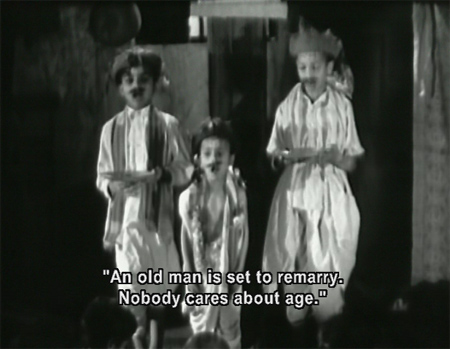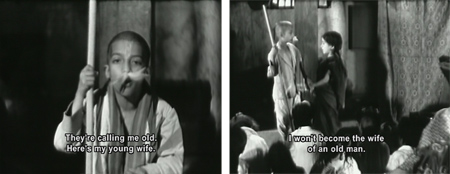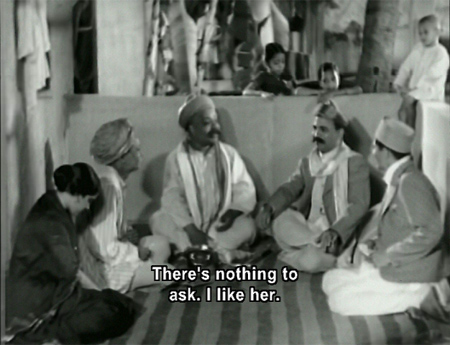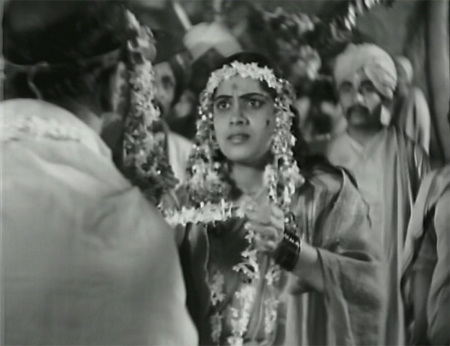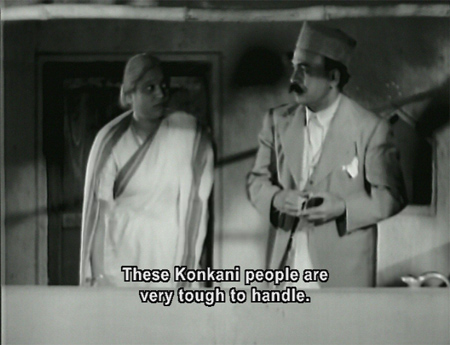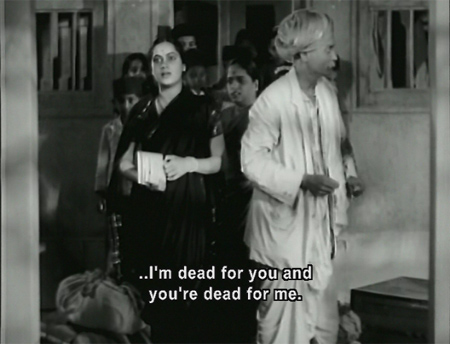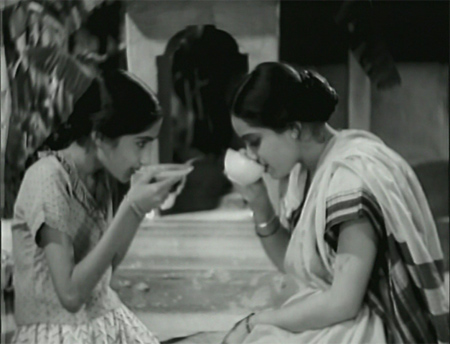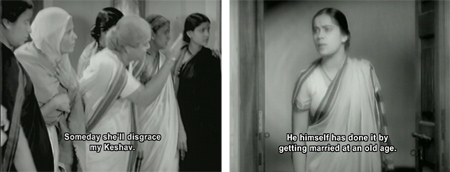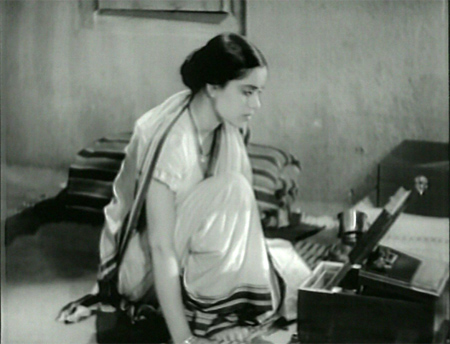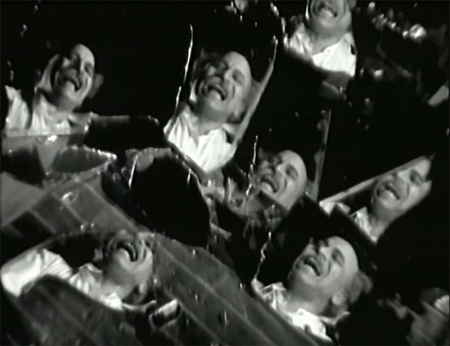This film by V. Shantaram for his Prabhat Films company is quite simply amazing (Kunku is the Marathi version, which I saw; the Hindi version is called Duniya Na Mane with the same cast and crew). It is made with such stark realism and simplicity that it takes your breath away, and the social commentary at the heart of the film seems (to me anyway) to be way before its time. There is also delightful humor (I laughed out loud in places) punctuating the somber and nuanced story, along with powerful performances. Shanta Apte shines as the fierce Neera, a young girl forcibly married off to a wealthy widower old enough to be her father; and Keshavrao Date is equally good as her groom. He begins as a selfish and not so sympathetic figure who evolves into an object of pity, hoping that this marriage will make him feel young again, and loved—alas, it doesn’t quite work out that way.
Plus of course, I love it because it’s old and there’s a sad dearth of Indian films this age. Look at the censorship certificate! And Prabhat’s symbol is so lovely too.
Orphaned Neera lives with her uncle and aunt and their brood of small children. Her uncle himself is quite elderly, and her shrewish aunt much younger. The children are presenting a play as the film opens. This is one of the cutest, most hilarious things I’ve ever seen—these kids are so small, flogged by their fluffy fake moustaches and prone to having their attention wander. One little kid removes his moustache and blows his nose on another kid’s dhoti before replacing it on his upper lip. The subject for their drama?
It all goes haywire when the little girl playing the bride doesn’t understand that it’s all fake, and has a melt-down—refusing to marry the old man.
Neera wipes her tears and sings a song for them: the music throughout the movie is either unaccompanied at all, or is accompanied by an old gramophone to add realism to the background music (and of course all the actors—including the kids—sing for themselves). I’ve heard Shanta Apte’s songs before, so it was fun to finally see her in a film.
I do have to admit, though, that as much as I love Hindi film music from the 1950s through the 1970s (and even beyond, except for disco—sorry!) I cannot say that I like many songs from the 1930s (the music in this is by Keshavrao Bhole). I think it might be an acquired taste.
In any case, Neera’s song is interrupted by the entrance of her aunt (Gauri), who is angry to find Neera playing with the kids instead of making bread or doing something else useful. It’s clear from their exchange that Neera’s parents brought her up with considerable love, and educated her; none of this endears her to her aunt.
Neera’s uncle (Chhotu) then appears to say that a wealthy lawyer is coming to “see” Neera as a marriage prospect.
Three men arrive: a pandit (or matchmaker), an older man, and a young man who looks like his son but calls him “Kakasaheb” when he defers to him for approval of the bride-to-be, which is quickly given.
Neera is given permission to leave, and peeps through the window at her prospective groom.
Riiiiiiight. Neera discovers the truth only on her wedding day when it’s time for garlands to be exchanged and she sees her groom’s face for the first time.
It is Kakasahab, the older man, the younger man having been a decoy; her uncle rushes forward and forces her to put the garland over his head. He has already been paid a generous amount for Neera, and nothing will stop the wedding if he can help it! Even her aunt is a little appalled, but the deed is done.
In a great scene, Neera confronts her uncle about his deception and his greed—but again, although her life is ruined, there’s nothing much she can do. She does refuse to show up for the wedding photograph, in another hilarious scene. Note the groom’s displeasure.
On the day she is to leave for her new home (a mansion, according to her aunt), her uncle is packing up the entire family to go with her. This isn’t going down too well with Kakasahab (whose actual name is Keshav) and his elderly aunt (Vimala Vasishta), although they are resigned to it.
But Neera herself puts a stop to this plan. “Nobody will go with me” she says firmly. There’s a steely determination in her face and manner which does not bode well for her new family (or her old one).
She departs for Gangapur with Keshav, his aunt and his daughter Akka (Vasanti)—who is close to Neera’s age herself, and clearly sympathetic.
On the morning they arrive in Gangapur, Neera refuses to take tea to Keshav, making his aunt—Kaki—furious. Kaki gives Akka a cup for herself and throws Neera’s tea in the sink. Akka takes her cup out to Neera and offers it to her shyly, and asks if she can call Neera “sister” instead of “aunt”; this is quite fine with Neera, and the two girls are soon fast friends.
Things don’t run as smoothly for others in the house. Neera flatly refuses to consummate her marriage, and sets up her own room in a warehouse which had been used as storage. She is full of righteous indignation, and never loses an opportunity to shame her new husband or his aunt. A typical exchange occurs when the neighboring women come to visit the bride, and she insults them. Kaki bemoans her rude behavior—but Neera has a ready retort.
So powerful and clear is her anger that Kaki and Keshav’s rage at her behavior is rendered impotent in the face of it. Secure in the knowledge that she has the moral upper hand and nothing left to lose, she is implacable; plus, she makes full use of her considerable intellect in outsmarting their attempts to force her into being a “proper” wife. As the days pass, though, she finds some joy in creating a courtyard garden with Akka, and in a diwali celebration with the neighboring women.
At work, Keshav’s colleagues are teasing him about having a young wife at his advanced age too, which doesn’t please him. An excellent example of the comic touches throughout this film comes as he is walking home one day, using his umbrella to shield himself from passers-by and their snide remarks. He runs into an older gentleman who starts to say something to him, and Keshav blows up:
His elder daughter Chitra—an outspoken advocate for women’s rights, we learn later in the film—also sends him a letter chastising him for ruining a young girl’s life.
Keshav is a vain man who dyes his moustache black and hates any reminder of or reference to his age. He has a grandfather clock which acts as the primary symbol in the film for his advancing years. The pendulum’s relentless tick-tock haunts him increasingly as his feelings change from rage at Neera’s defiance, to frustration and finally to shame.
I’m not going to say more on the story. I just really highly highly recommend this as one of the most progressive and thoughtful films I’ve ever seen, anywhere. It avoids being too preachy with its clever humor, and by its simple humanity: the characters are believable and real people. Neera, for all her rebellion, is at heart traditional (for her time!), who wants a husband she can look up to and please. She is no avenging goddess, just a wronged girl.
There is plenty of pointed symbolism, too, besides the clock. One of my favorite scenes is one where Neera’s uncle turns up; she sends for the police and tells them that he’s an insane man who thinks he’s her uncle. They haul him off to a mental hospital as he shouts imprecations at her treatment of him and a donkey brays nearby in the exact same tone. Neera also visibly struggles each morning when it’s time to apply the vermilion to her forehead in front of her mirror.
There is also some great imagery, as when Keshav breaks his mirror in a fit of despair and his reflection in the shards of glass mocks him.
The ending is not much of a surprise, but certainly gives plenty of food for thought (although I don’t want to give it away here).
Edited to add: the comments now contain spoilers, so don’t read them if you don’t want to know how it ends!
This came as part of a ten-disc set of Prabhat films which includes 1932’s Ayodhyecha Raja—with subtitles—so I’ll be rewatching that one too (and hopefully enjoying it more than I did the first time without subs). But whatever comes of the rest of the set, this is truly a work of art.


